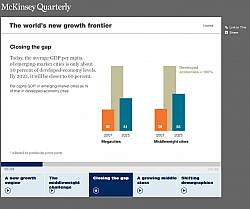Mc Kinsey - middle-class middleweight cities to drive gdp growth in next 15 years
Over the next 15 years, the number of children in middle-class households in emerging market cities around the world may grow 10 times faster than those in developed countries. This future generation living in places such as China, Latin America and South Asia should drive the demand for goods and services, housing and transportation that extend beyond the basic necessities of life. In McKinsey Global Institute’s recently published report, “Urban world: Mapping the Economic Power of Cities,” the researchers focus on demographic and economic trends to determine which cities will provide the most economic growth in the future.
Half of the world’s population already lives in cities, generating more than 80 percent of global GDP today. But the urban economic story
is even more concentrated than this suggests. Only 600 urban centers, with a fifth of the world’s population, generate 50% of global GDP. In 2025, we still expect 600 cities to account for about 60% of worldwide GDP. Over the next 15 years, the makeup of the group of top 600 cities will change as the center of gravity of the urban world moves south and, even more decisively, east. One of every three developed market cities will no longer make the top 600, and one out of every 20 cities in emerging markets is likely to see its rank drop out of the top 600. By 2025, we expect 136 new cities to enter the top 600, all of them from the developing world and overwhelmingly (100 new cities) from China. These include cities such as Haerbin, Shantou, and Guiyang.
Contrary to common perception, megacities have not been driving global growth for the past 15 years. In fact, many have not grown faster than their host economies, and we expect this trend to continue. We estimate that today’s 23 megacities will contribute just over 10 percent of global growth to 2025, below their 14 percent share of global GDP today. Instead, we see the 577 fast-growing middleweights in the City 600 contributing half of global growth to 2025, gaining share from today’s megacities. Worldwide, we will see 13 middleweight cities become megacities by 2025, 12 of which are in emerging markets (the exception is Chicago) and seven in China alone. Emerging market mega- and middleweight cities together—423 of them are
included in the City 600—are expected to contribute more than 45 percent of global growth from 2007 to 2025. Across the world, we see 407 emerging market middleweights contributing nearly 40 percent of global growth, more than the developed world and developing region megacities put together.
http://www.mckinsey.com/mgi/publications/urban_world/index.asp






